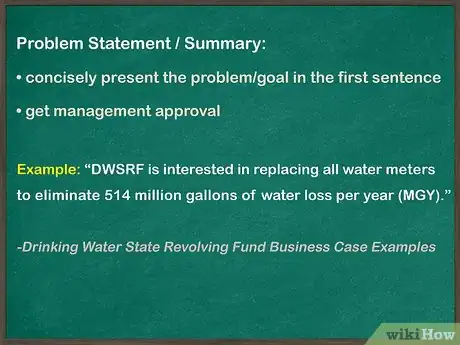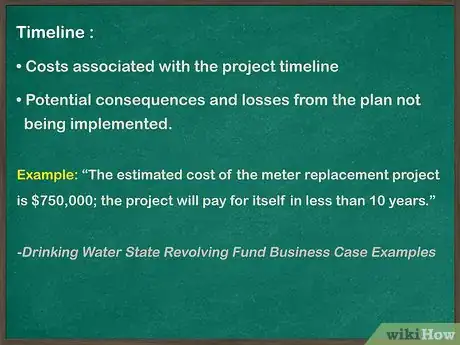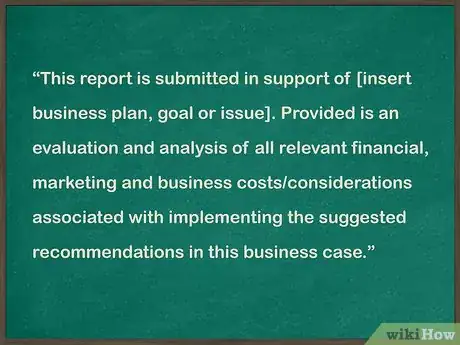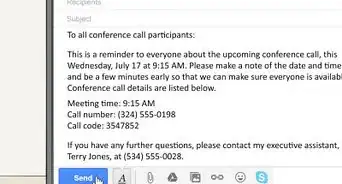This article was co-authored by Michael R. Lewis. Michael R. Lewis is a retired corporate executive, entrepreneur, and investment advisor in Texas. He has over 40 years of experience in business and finance, including as a Vice President for Blue Cross Blue Shield of Texas. He has a BBA in Industrial Management from the University of Texas at Austin.
wikiHow marks an article as reader-approved once it receives enough positive feedback. This article received 11 testimonials and 98% of readers who voted found it helpful, earning it our reader-approved status.
This article has been viewed 427,839 times.
A business case provides justification for a proposed business change or plan, and typically outlines the allocation of capital and resources required to implement the proposed business case. A successfully presented business case can act as an impetus for moving forward with a new, alternative plan of action, or it may simply provide a consistent message, or unified vision for future business decisions and operations. A well-drafted business case will expose major or implementable solutions for conquering a business problem, issue or goal in order to provide decision makers with multiple options to choose from.
Steps
Understanding the Business Case Subject
-
1Identify and thoroughly understand a relevant business problem, issue or goal. Your first step in creating a successful business case is to clearly identify the business problem, issue or goal that your business case will address. Hold a brainstorming session with your business’s decision makers and managers in order to understand the problems that arose and the business goals surrounding the problems.[1]
- It is crucial to clearly define the problem and parameter of the solution. There should be an agreement about the scope between the person authorizing the business case and those who will execute analysis.
- Justification for the project could be based on the benefits to business operations, strategic direction goals, and/or cost benefit analysis.
-
2Brainstorm about potential options for resolving the business case problem, issue or goal. Both during, and after your initial business case brainstorming session, you should discuss potential solutions and plans with key personnel and management. Identify multiple options for implementing your business case plan in order to determine the most feasible option for resolution.
- For example, if the business case plan revolves around entering a new market, there should be a brainstorming session held in order to determine that different marketing strategies required to make the new market entry a success.
- Don’t just go off and write the business case independently, because successful approval and implementation is dependent on support from relevant business stakeholders and managers.
Advertisement -
3Review your business’s mission statement. Once you have identified potential business problems, issues or goals, and potential options for resolution, you should briefly review your business' mission statement. A well-drafted mission statement should have been created during the initial business planning process, and typically includes a brief explanation of the business’s objectives, competitive/market advantages and a short explanation of the business’s philosophies and goals. Consider whether your business case is in-line with the mission statement in terms of complying with and furthering business goals, objectives and philosophies.[2]
- Reviewing the mission statement can allow you determine whether the business case and proposed resolution options further the ultimate mission and goals of the business.
- In most cases, you will be following the directions of a superior whose responsibility is to confirm compatibility between mission and the alternative solutions you provide.
-
4Determine who should write the business case. Typically, one or two people take on the duty of writing a business case. With just one or two writers, the tone and style of the business case will remain consistent. The writer(s) should have knowledge and expertise regarding relevant business operations, and must be open to accepting input from other team members and business leaders.
Creating a Strong, Persuasive Business Case
-
1Write down the problem statement. This statement should provide a straightforward explanation of the identified business problem or issue, and discuss the business areas that the business case must address for successful implementation.[3]
- Use the first sentence of the problem statement to concisely present the problem, issue or goal that the business case seeks to resolve. For example, if the business problem is the need to generate additional lines of revenue the problem statement should begin with a statement that: “[Insert business name] is interested in expanding its current revenue stream by [business case’s proposed answer to the business problem].”
- Get the approval of those requiring the report before continuing.
-
2Create a proposed solutions statement. Express the projects and options proposed by the group as a solution to the business problem, goal or issue. Explain in detail how the proposed change/plan addresses and resolves the problem, issue or goal. Include what should be accomplished by implementing the proposed business case plan.
- Indicate what is needed to implement the solution or project, including items like a monetary budget and increased labor numbers. Anything that is needed to complete this solution should be explained in the proposed solutions statement.
- Explain the methods used, and the research conducted in order to come up with the business case plan’s proposed options.
- Include information about meetings with surveyed departments and target audiences.
-
3Provide detailed timelines and time frames for successful project implementation and completion. Provide ideal dates and worst-case scenarios for plan implementation, as well as a more general time frame for business case plan implementation and completion.
- Provide the costs associated with the project implementation timeline, as well as the potential costs/losses associated with not implementing the proposed business case plan.
- Explain the potential consequences and losses that could result from the plan not being implemented.
-
4Draft an executive summary. The executive summary is the first, and most important part of the business case. The business case executive summary outlines the proposed project, that if implemented, would further the identified business goal, and/or resolve the identified business problem or issue. The executive summary will contain the major considerations that will be later discussed in more detail, including the timeline for business case implementation and completion, as well as the projected benefits and costs of business case implementation. [4]
- Begin your executive summary with language such as: “This report is submitted in support of [insert business plan, goal or issue]. Provided is an evaluation and analysis of all relevant financial, marketing and business costs/considerations associated with implementing the suggested recommendations in this business case.”
- From there provide an explanation of why the proposed business plan should be implemented, and identify the impacts on the business for not implementing the plan.
Organizing and Presenting a Strong, Persuasive Business Case
-
1Edit your business case draft. After you have completed a first draft of your business case, your next step should be to carefully review your business case for any unnecessary language and grammatical errors. Make sure your business case is formatted in a manner that is easy to read and clearly displays each of the separate business case sections in underlined or bolded text.
-
2Present your business case to the personnel who will be instrumental in implementing the business case plan. Get the agreement and feedback of those who will be responsible for implementation. Although, they are not usually the decision makers, the best way to ensure that your business case will be successful is by making sure that the personnel responsible for implementing the plan have the opportunity to review the business case and offer suggestions for changes and other feedback.[5]
- For example, if your business case suggests the implementation of a new marketing strategy as a means to enter new markets, you should definitely take the time to meet with the marketing team in order to ensure that the processes contained in your business case can be feasible implemented by marketing personnel.
-
3Present your business case to final authority. Your business case should be presented to the management professionals who are responsible for providing approval for new business strategies or plans. Begin with the problem, issue or goal that your business case is addressing. From there talk about the resolution provided by your business case, as well as the different options, and steps that must be taking to bring about resolution.[6]
- Consider using a PowerPoint presentation to add visuals to your business case presentation.
- Brainstorm in advance about any potential concerns that management may have about implementing the business case plan. Make sure to address these concerns during your presentation, instead of waiting for management to raise their concerns.
References
- ↑ http://whatis.techtarget.com/definition/How-to-write-a-business-case-document#anchor2
- ↑ http://www.entrepreneur.com/encyclopedia/mission-statement
- ↑ http://whatis.techtarget.com/definition/How-to-write-a-business-case-document#anchor2
- ↑ http://whatis.techtarget.com/definition/How-to-write-a-business-case-document#anchor2
- ↑ http://www.ftpress.com/articles/article.aspx?p=360437
- ↑ https://hbr.org/2014/07/the-right-way-to-present-your-business-case
About This Article
To write a business case, start with a straightforward explanation of the problem, issue, or goal. Next, list the most feasible options for resolution and explain in detail how these options will resolve the problem or issue. Indicate exactly what's needed to implement each solution, such as budget increases and additional labor, and be sure to provide detailed timelines for successful implementation and completion! For tips on organizing and formatting your business case, read on!









































































